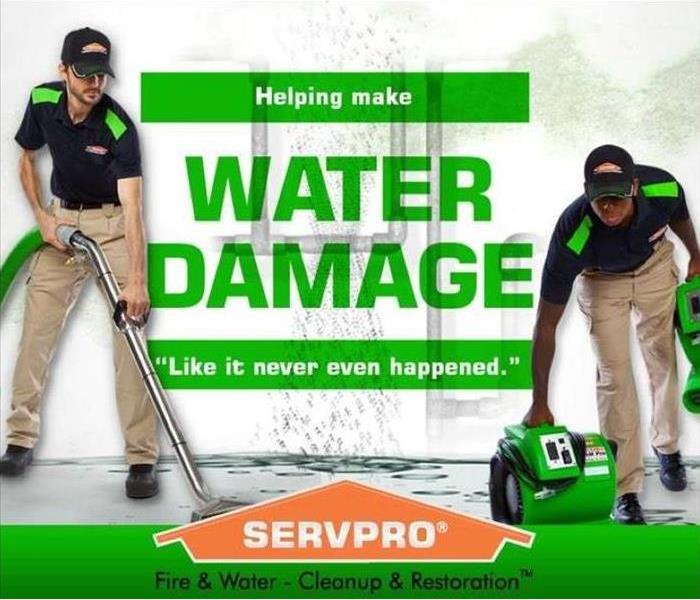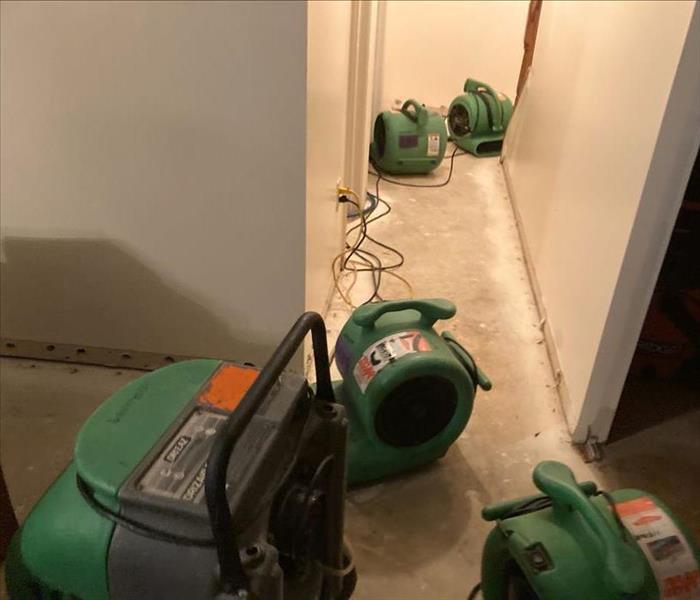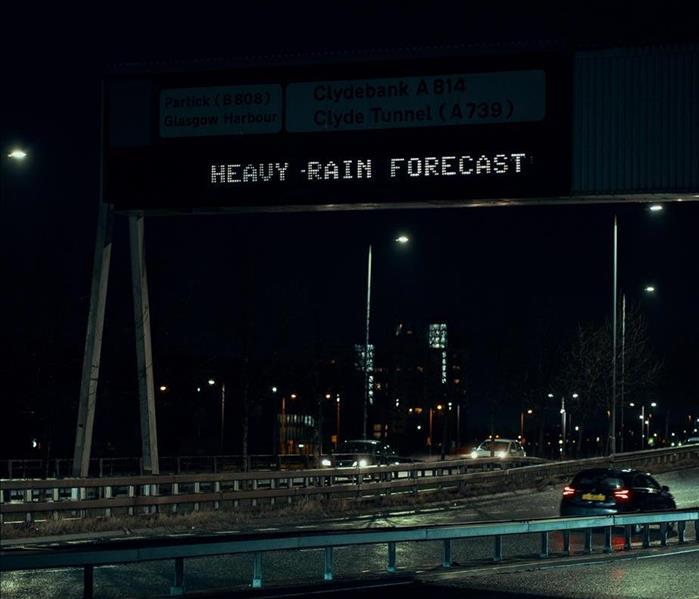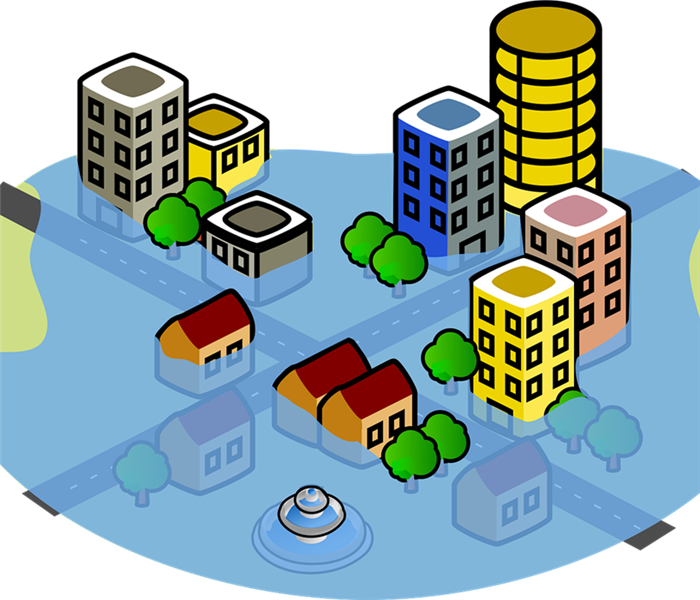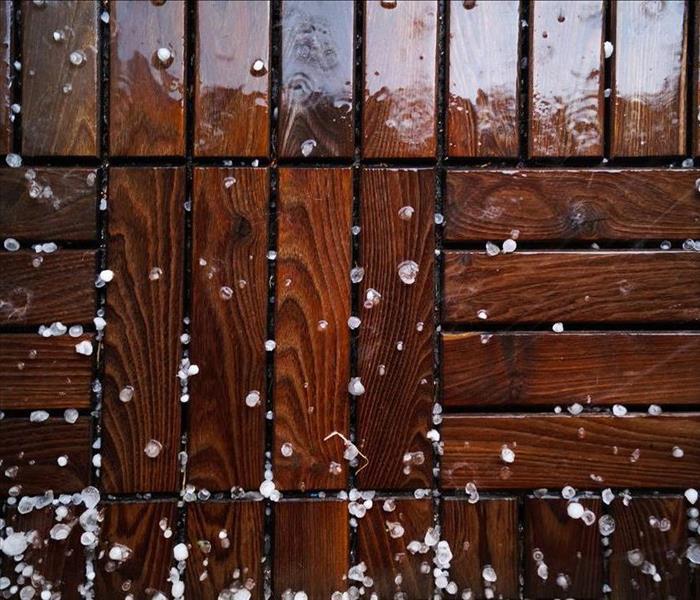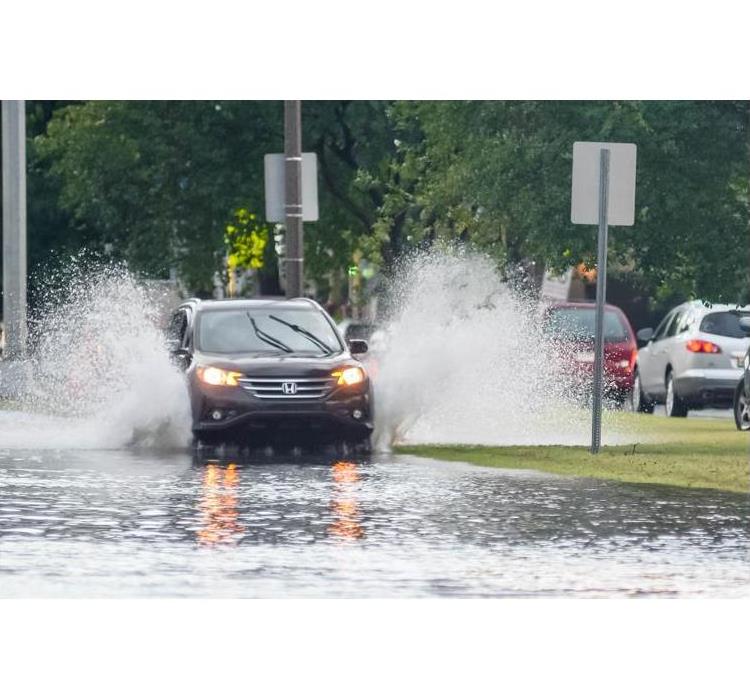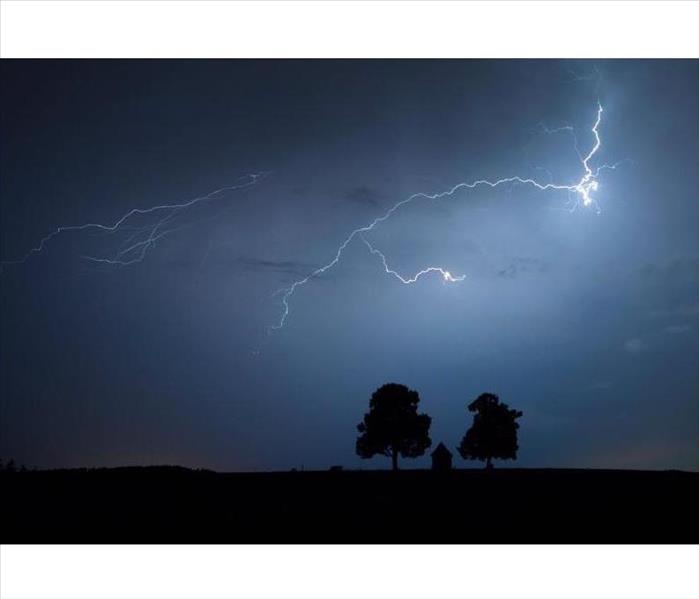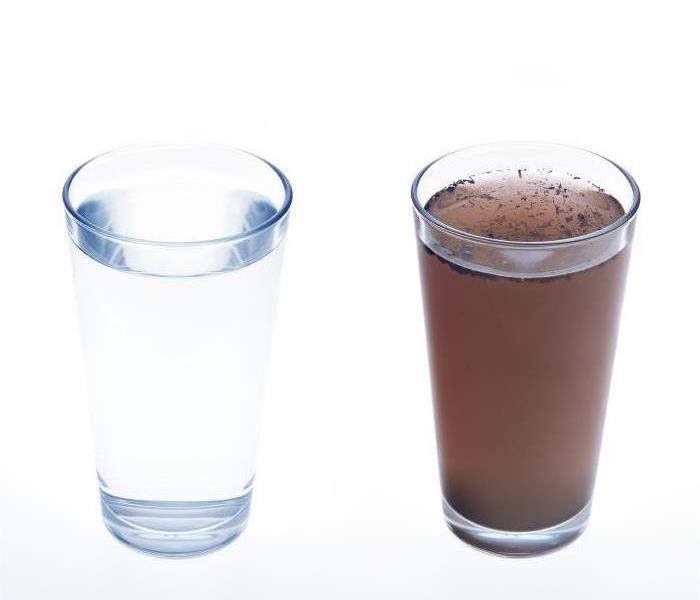Recent Water Damage Posts
How to Handle Clean Water VS Contaminated Water
8/15/2023 (Permalink)
When your property has suffered water damage, leave it to SERVPRO of College Park, Hyattsville and SERVPRO of District Heights / Landover to take care of your water damage needs. It is important to understand the type of water you are dealing with to ensure proper cleanup. There are three types of water: clean water, gray water, and black water. Consider the following steps to help minimize damage or prevent further damage while waiting for help to arrive.
Three Types of Water
Clean water is water from a broken pipe, or other water source; rainwater is also considered clean water.
Gray water is clean water that has been untreated. Bacteria and other contaminants begin to grow on the clean water making the water hazardous.
Black water is highly contaminated water filled with fungi, bacteria, chemicals and more. Black water usually occurs from sewage damage, flooding or any natural disaster.
Damage from clean water tips
- Shut off the water source if possible, or contact our SERVPRO professionals to do so.
- Remove as much access water as possible by mopping and blotting.
- Remove and pop up wet upholstery cushions for even drying.
- Do not enter rooms with standing water, as electrical shock hazards may exist.
- Do not use your household vacuum cleaner to remove water as there is potential for electrical shock or causing damage to the vacuum cleaner.
Damage from contaminated water
- Avoid all contact with sewage and items contaminated by sewage
- Do not want through contaminated areas
- Do not turn on HVAC system if there is a possibility of spreading contaminated air
- Do not use household fans to dry the structure air flow can spread contamination
- Discard any food or products of personal hygiene if exposed to contaminated areas
Feel Free to reach out to our team for your restoration needs. SERVPRO of College Park, Hyattsville and SERVPRO District Heights / Landover are here to assist you! Call us at 301-779-3662
Protecting Your Prince George’s Property from Water Damage
6/10/2022 (Permalink)
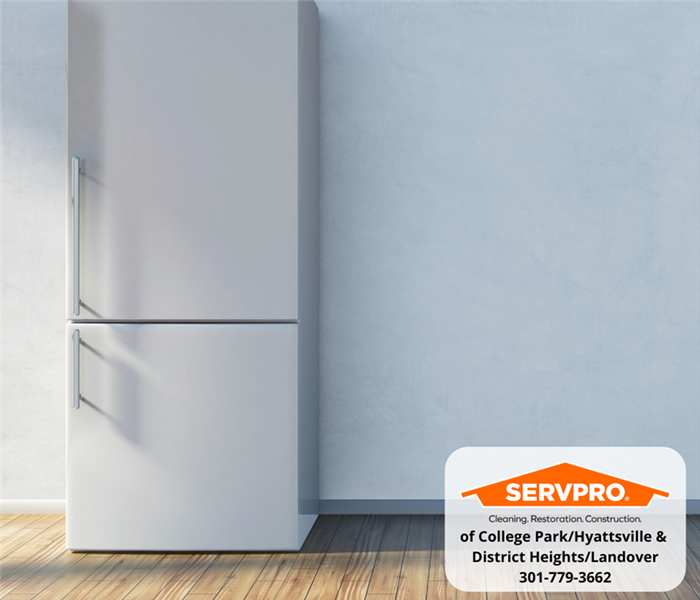 SERVPRO of College Park/Hyattsville and SERVPRO of District Heights/Landover provide emergency cleaning and restoration services 24 hours a day, 7 day
SERVPRO of College Park/Hyattsville and SERVPRO of District Heights/Landover provide emergency cleaning and restoration services 24 hours a day, 7 day
Water Damage Happens in College Park, Hyattsville, District Heights, & Landover
SERVPRO® of College Park/Hyattsville and SERVPRO® of District Heights/Landover has been restoring water damage in Prince George’s County for years. Our certified professionals use the most advanced equipment to detect hidden moisture and extract standing water. Every water damage event is a little different and requires a unique solution, but the process stays the same. Water damage mitigation services commonly consist of drying, cleaning, and sanitizing contaminated areas and items. Here are some refrigerator and ice maker operation tips to reduce your risk of water damage:
- Install the ice maker supply line hose properly to avoid water damage.
- Tightly connect the hose to the valve and avoid tightening.
- Inspect the hose every six months and ensure the valve connection is secure and no kinks are present.
- Leave a three- or four-inch space between the back of the refrigerator and the wall to prevent the hose from crimping.
- Locate the water shut-off valve.
The SERVPRO® Water Damage Restoration Process
Step 1: Emergency Contact
Step 2: Inspection and Water Damage Assessment
Step 3: Water Removal / Water Extraction
Step 4: Drying and Dehumidification
Step 5: Cleaning and Sanitizing
Step 6: Restoration
Emergency Contact – 301-779-3662
SERVPRO® of College Park/Hyattsville and SERVPRO® of District Heights/Landover has highly trained certified technicians ready to respond to water emergencies 24/7 in College Park, Hyattsville, District Heights, and Landover. We have the advanced equipment and experience to help ensure your home is clean, dry, and restored to its pre-damaged condition.
Independently Owned and Operated.
Water Damage After a Fire In Prince George’s County
4/20/2022 (Permalink)
After experiencing a fire in your home or business, the damages can be extensive. Firefighting efforts can put thousands of gallons of water into your home in minutes. Fire suppression is important when protecting your family, personal belonging, and structure from further fire damage. The intense heat of a fire can also melt plastic pipes quickly or cause structural weakness in metal pipes that can cause plumbing bursts. Water damage and fire damage add to the workload of the recovery and restoration process.
Fire Damage Restoration Process
Once emergency officials have cleared the area, our certified technicians will carefully inspect and test adjoining rooms of your property to determine the extent of the water damage. This step is important for developing a plan of action. Our certified technicians will complete a full scope of work at the beginning of the project and provide you with an estimated timeline to know what to expect moving forward.
- Immediate Board-Up and Roof-Tarp Service
- Water Removal and Drying (if water damage is present)
- Removal of Smoke and Soot from All Surfaces
- Cleaning and Sanitizing
- Restoration
Our team works on a plan that includes fire and smoke damage and extensive water damage from firefighting efforts. SERVPRO of College Park/Hyattsville and SERVPRO of District Heights/Landover has the specialized water mitigation training needed to restore your home to pre-existing conditions. While fire damage produces immediate damage, water damage is a gradual problem that can grow more destructive if left untreated. The water can cause mold growth and mildew, weaken the wood and home structure, and create poor air quality.
SERVPRO Water Damage & Fire Damage Restoration
Our certified technicians can help in the aftermath of fire damage. SERVPRO of College Park/Hyattsville and SERVPRO of District Heights/Landover are experts in water damage restoration. We can make it “Like it never even happened.” To learn more about our services and schedule an inspection, call us today at 301-530-7400 or 301-588-2240.
Dealing With Water Damage: Home Edition
3/30/2022 (Permalink)
When water damage strikes your home, the first 24 hours following a water loss are the most important in preventing secondary or permanent damage. Within four hours of receiving your call, our certified technicians will be at your property to help ensure that the water damage is handled properly. Read more to learn what you could do while waiting for assistance.
Water Damage Tips for Homeowners
- If possible, shut off the water source or contact a qualified party to stop the water source.
- Do not enter affected areas if electrical outlets, switches, circuit breakers, or electrical equipment are exposed to water.
- When access to the power distribution panel is safe from electrical shock, turn off circuit breakers for wet areas of the home.
- Do not turn on ceiling fixtures if the ceiling is wet or enter rooms where ceilings are sagging from retained water.
- Do not use your household vacuum cleaner to remove water.
- Remove as much excess water as possible by blotting and mopping.
- Remove and prop up wet upholstery cushions for even drying.
- Use aluminum foil as a barrier between furniture legs and wet carpeting.
- Move any paintings, art, objects, computers, documents, or other sensitive valuables to a dry place.
- Hang furs and leather goods separately at room temperature.
When you call SERVPRO of College Park/Hyattsville & SERVPRO of District Heights/Landover, a customer care specialist will ask several questions regarding your water damage emergency. Here are a series of questions you will be asked:
- Your name and POC information
- Address of the water-damaged home or business
- The cause of the water damage
- The square footage of the affected area
- Insurance information, on a case-to-case bases
Once we have the details of your water event, we will dispatch a team to respond immediately. When our certified professionals arrive, they’ll help you assess the situation further and take action to prevent additional damages to your home or business. SERVPRO of College Park/Hyattsville & SERVPRO of District Heights/Landover uses the most top-notch equipment to detect hidden moisture and extract standing water.
Have Water Damage or Flood Damage?
Call Us Today at 301-577-1166 or 301-799-3662
Flooded Basement Cleanup and Restoration in College Park, Hyattsville, District Heights, & Landover
2/25/2022 (Permalink)
 Flooded Basement? SERVPRO of College Park/Hyattsville & SERVPRO of District Heights/Landover Can Help!
Flooded Basement? SERVPRO of College Park/Hyattsville & SERVPRO of District Heights/Landover Can Help!
A flooded basement is something you do not want to see. A basement water intrusion can damage your carpet, flooring, drywall, baseboards, furnishing, and appliances. SERVPRO of College Park/Hyattsville and SERVPRO of District Heights/Landover has you covered. Our water damage restoration specialists are ready to restore your College Park, Hyattsville, District Heights, and Landover homes to pre-water damage conditions. The faster we can start mitigating the water damage, the quicker we can restore your home to make it “Like It Never Even Happened.”
What should I do after a basement flood?
- If possible, shut off the water source. If the source is unidentifiable, we recommend hiring a plumber.
- Check to see if your sump pump or drain is in working condition. If the sump pump and drain appear to be clogged, get the area unclogged so they can drain any water from the basement after flooding.
- Remove excess water by mopping, blotting, or wiping.
- Protect carpet, rugs, drapes, and upholstered items from further water damage. Place aluminum foil between furniture and carpets. Remove any important documents, family heirlooms.
- Avoid using electric or electronic items that have come in contact with water.
Causes of Basement Flooding
- Broken sump pump
- Supply line leakage
- Plumbing leaks
- Poor weatherproofing
- Improper drainage system
- Clogged gutters
- Downspouts Failure
At SERVPRO of College Park/Hyattsville and SERVPRO of District Heights/Landover, we have the expertise and advanced training that enables us to get your basement dried properly and any affected belongings cleaned and dried. We have been serving the College Park, Hyattsville, District Heights, and Landover area for more than 45+ years. Call us today at 301-799-3662 or 301-577-1166.
What Is Our Water Damage Process?
1/26/2022 (Permalink)
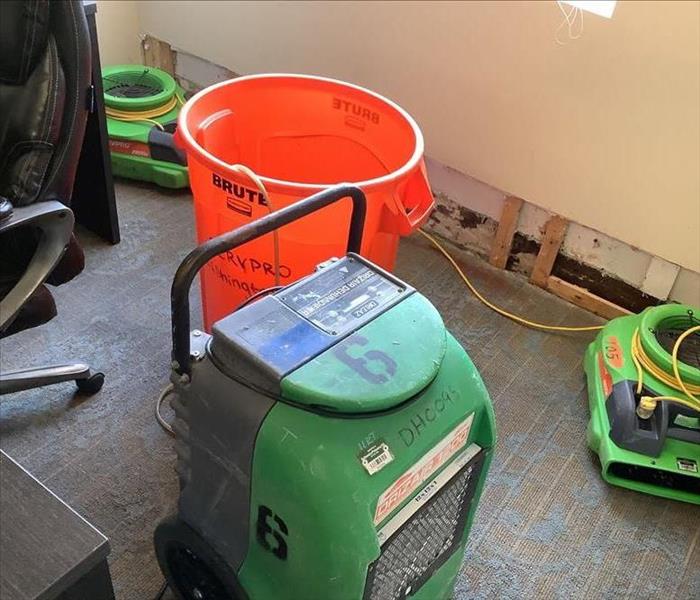 Our certified technician will explain the needed water emergency services to you step-by-step.
Our certified technician will explain the needed water emergency services to you step-by-step.
SERVPRO of College Park/Hyattsville and SERVPRO of District Heights/Landover are available 24 hours a day, 365 days a year for commercial and residential water emergencies in Prince George’s County. The first 24 hours after a water loss are crucial for avoiding further or permanent damage. SERVPRO has specific water damage training and experience to help you through this challenging time. We specialize in the cleanup and restoration industry; our franchise owner has been in the business for 45+ years.
SERVPRO of College Park/Hyattsville and SERVPRO of District Heights/Landover certified professionals will be on-site to help ensure that the water damage is taken care of by completing the following steps:
Inspection
SERVPRO of College Park/Hyattsville and SERVPRO of District Heights/Landover certified technicians inspect the area affected to determine the extent of the damage. The technician will then review the inspection with you to answer any questions. Our technician will provide you with a preliminary estimate before we begin the work.
Emergency Services
Our certified technician will explain the needed emergency services to you step-by-step. SERVPRO professionals will protect your home or business, as well as personal property and other contents, from further damage by extracting the excess water.
Monitoring
To help ensure your home or business and personal belongings are dried to appropriate industry standards, a SERVPRO certified professional will monitor the drying process. The updates will be consistently communicated with you.
Restoration Services
SERVPRO of College Park/Hyattsville and SERVPRO of District Heights/Landover professionals will repair structural materials, reinstall carpets, and clean affected areas of your property and contents. A final walk-through of the job site will be conducted with you to help ensure your home or business was returned to its preloss condition.
Our certified professionals at SERVPRO of College Park/Hyattsville and SERVPRO of District Heights/Landover are here for you 24/7 every day of the year. Call us at 301-799-3662 or 301-577-1166.
For more information on recovering from water damage, contact your local SERVPRO franchise professionals.
How To Prevent Washing Machine Water Damage
12/2/2021 (Permalink)
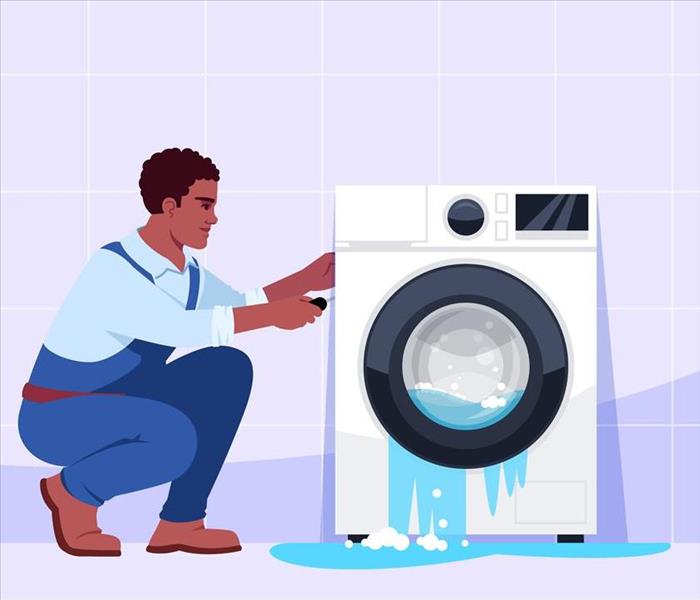 SERVPRO certified technicians are trained and experienced in all phases of water damage mitigation.
SERVPRO certified technicians are trained and experienced in all phases of water damage mitigation.
One of the most common causes of water damage in a home comes from washing machine hoses. A leaking washing machine hose can cause water damage and potentially damage the subfloors of your home. Our SERVPRO certified technicians can limit water damage in your home or business and prevent further damage.
What causes hoses failure?
One of the most common reasons is the material in traditional rubber hoses. Rubber hoses lose their structure over time and are subject to cracks, leaks, and bursting. In addition, most hoses will eventually break from everyday wear and tear. Every time the washing machine shuts off, water sends shockwaves through the water pipes and hoses.
When water damage occurs in your home, time is of the essence, which is why we can respond to your calls 24 hours a day. SERVPRO of College Park/Hyattsville and SERVPRO of District Heights/Landover will dispatch a crew of certified technicians. Our technicians will promptly arrive at your home to begin a fast mitigation process. Leaks from washing machines are tackled with industrial-grade wet vacuums to clean up standing water.
Water Clean-Up in College Park/Hyattsville/District Heights/Landover
The project manager will start the mitigation process by searching for moisture reading in your home. We can identify moisture levels in your carpet and flooring using a moisture meter. Once moisture readings are reading dry, we can use carpet tools to separate the carpet from the subflooring. Keep in mind that some carpeting may have to be discarded and replaced depending on the water damage.
To ensure that the sub-flooring is not at risk of rotting, we can deploy air movers to force water out of the floor. Placing dehumidifiers can also draw moisture from the wood to quickly dry out your home.
If you have experienced a washing machine leak and need assistance, contact SERVPRO of College Park/Hyattsville and SERVPRO of District Heights/Landover at 301-799-3662 and 301-577-1166. We are available 24/7 and can immediately put you on track to getting your home back in order.
Burst Pipe Overflow? We can help!
10/15/2021 (Permalink)
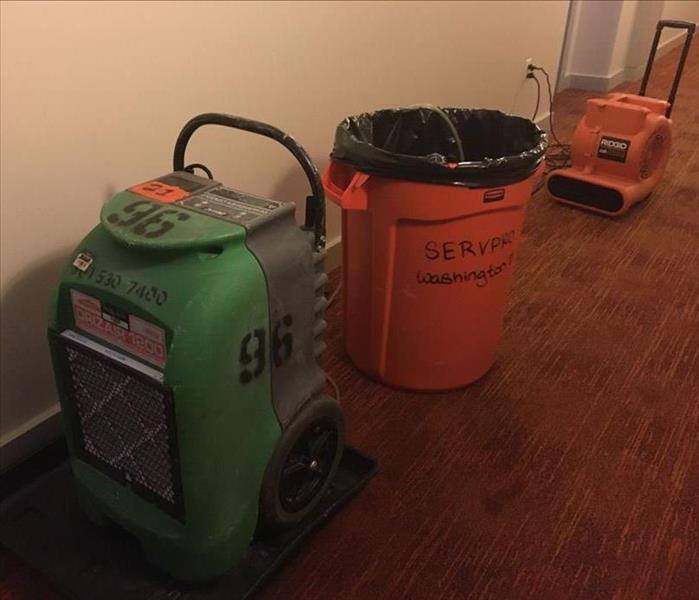 Call SERVPRO of College Park/Hyattsville and SERVPRO of District Heights/Landover the experts in fire & water, mold, and bio-hazards remediation.
Call SERVPRO of College Park/Hyattsville and SERVPRO of District Heights/Landover the experts in fire & water, mold, and bio-hazards remediation.
Get fast water removal after a burst pipe with the help of SERVPRO of College Park/Hyattsville and SERVPRO of District Heights/ Landover.
Indoor plumbing can quickly cause damage to the structure and contents of your home. You may think you can take care of a pipe burst clean-up on your own, but this requires the help of professionals. SERVPRO of College Park/Hyattsville and SERVPRO of District Heights/Landover can provide you with water removal services. Every homeowner cares about protecting their property, and poor cleaning can create more significant damages.
Our certified technicians understand that water damage situations are time-sensitive. The longer the water lingers throughout the affected areas, the structure and materials can weaken and become even more damaged.
Fixing the source of the water and shutting off the water is essential when requesting water mitigation services. Before our SERVPRO team can start the restoration process, you must ensure that the source is fixed. When the problem has been located, we can get the pipe repaired and reassure that water does not contribute to mold or a recurring disaster event.
Our highly trained technicians will determine what equipment should be used depending on the amount of water. During the water removal process, technicians will carefully monitor the drying progress using moisture meters until the materials read acceptable drying goals. In addition to cleaning your property’s structure, we will clean your furniture, upholstery, clothing, and other restorable belongings damaged by the water. Most flooding and water damage also require odor removal and deodorization by professionals.
Your home can face multiple threats in a lifetime. You can not always account for or prevent some of them. Most homeowners do not realize there is a problem until they face the pool of water the incident created. Trust in our SERVPRO of College Park/Hyattsville and SERVPRO of District Heights/Landover technicians to help you clean up the mess, remove the water, and get back to your regular life. You can call us 24/7 at 301-779-3662 or 301-577-1166.
When Accidents Happen, count on SERVPRO of College Park/Hyattsville and SERVPRO of District Heights/Landover to make it “Like it never even happened.”
Heavy Rains And Water Damage In Our Area
8/12/2021 (Permalink)
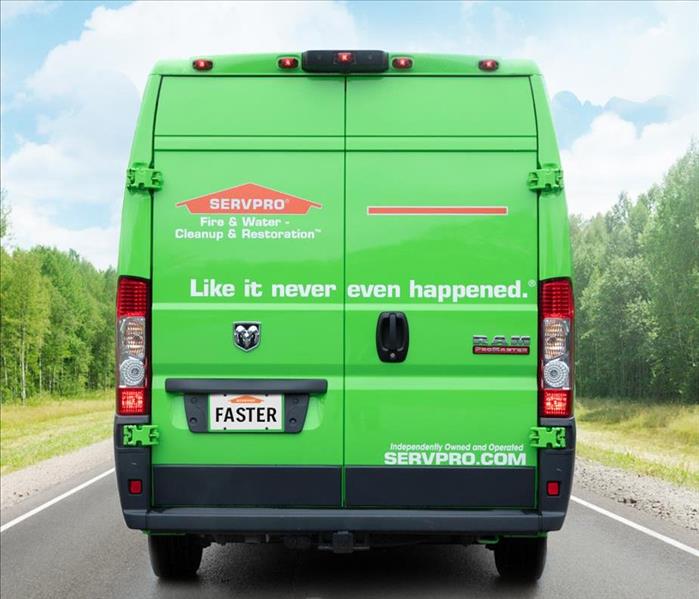 SERVPRO of College Park / Hyattsville and SERVPRO of District Heights / Landover is on call 24 hours a day for water mitigation and restoration
SERVPRO of College Park / Hyattsville and SERVPRO of District Heights / Landover is on call 24 hours a day for water mitigation and restoration
Water Damage In College Park / Hyattsville / District Heights / Landover
While all types of water can damage your property, some are more damaging than others. When your property suffers water damage, understanding what type of water you are dealing with is critical to ensure proper cleanup. Experts have broken down water into three types of categories. Read on to see which type of water contamination can be on your property.
Category 1: Clean Water
Clean water originates from a broken pipe or a supply line. If not treated, clean water is likely to convert to gray water. Clean water left untreated allows bacteria to grow as well as other contaminants.
Category 2: Gray Water
Overflows from home appliances like a dishwasher to a washing machine can be the cause of Gray water. Gray water contains mild contamination, however not enough to be considered a biohazard. If left untreated, the water can quickly become black water.
Category 3: Black Water
Black water ranges from sewage damage, flooding or any natural disaster. Black water is highly contaminated and filled with fungi, bacteria, chemicals, and more. Water from sewer backups should be considered very dangerous and can cause massive amounts of water damage. Black water should be remediated by trained professionals.
Sewage Backup or Toilet Overflow? Call Us Today – (301) 779-3662 or 301-577-1166
Call your local SERVPRO® franchise professionals. SERVPRO® of College Park / Hyattsville and SERVPRO® of District Heights / Landover technicians will inspect the water damage to determine the appropriate response to restore your home or business safely. We are on call 24/7 hours a day, including weekends and holidays. Call SERVPRO® of College Park / Hyattsville and SERVPRO® of District Heights / Landover at 301-779-3662 or 301-577-1166.
Wet Carpet? SERVPRO is Here to Help!
6/11/2021 (Permalink)
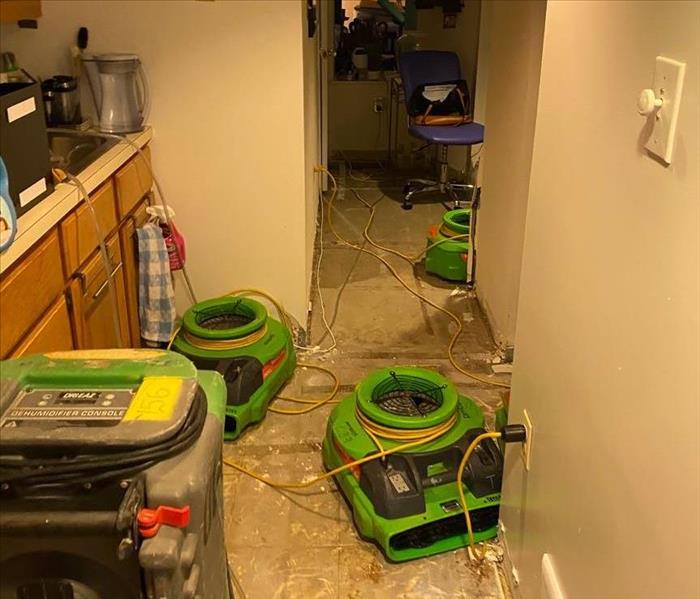 Call us today at 301-530-7400 if you have recently experienced water damage to your property
Call us today at 301-530-7400 if you have recently experienced water damage to your property
When you have a flood on your property, you must act quickly. Floods, leaks, spills, or burst pipes can all weaken your carpet and gather microorganisms. If you do not address the water right away, you might face major problems like mold in your property. The best solution is to call in trained, experienced professionals.
SERVPRO of College Park/Hyattsville and SERVPRO of District Heights/Landover are HERE TO HELP when your home or business has suffered water damage. Our technicians use several methods to clean carpets. At SERVPRO, we have five carpet methods and determine the proper cleaning method for you based on the inspection.
SERVPRO carpet cleaning methods in order of least aggressive to most aggressive are as follows:
- Bonnet Cleaning
- Hot Water Extraction
- Deluxe Precondition and Rinse
- Rotary Jet Extraction
- Showcase
Our technicians check and test to determine the level of damage and how far the moisture has migrated to ensure a successful and complete restoration. While we are on-site, we will also look for any potential safety hazards. A homeowner in the College Park/Hyattsville area recently experienced flood damage in his home when a pipe burst from a water filtration system and the entire basement was affected. Our technicians ran equipment to extract and dry affected materials.
"Like it never even happened."®
Floods and overflowing water emergencies do not wait for regular business hours, and neither do we. To avoid renting expenses, replacing your carpet, and extra expenses, call for reinforcements. Call SERVPRO of College/Park and SERVPRO of District Heights/Landover for water damage restoration at 301-530-7400.
We are on call 24 hours a day, 7-days a week, including holidays.
Water Damage? Know Who and When to Call
5/20/2021 (Permalink)
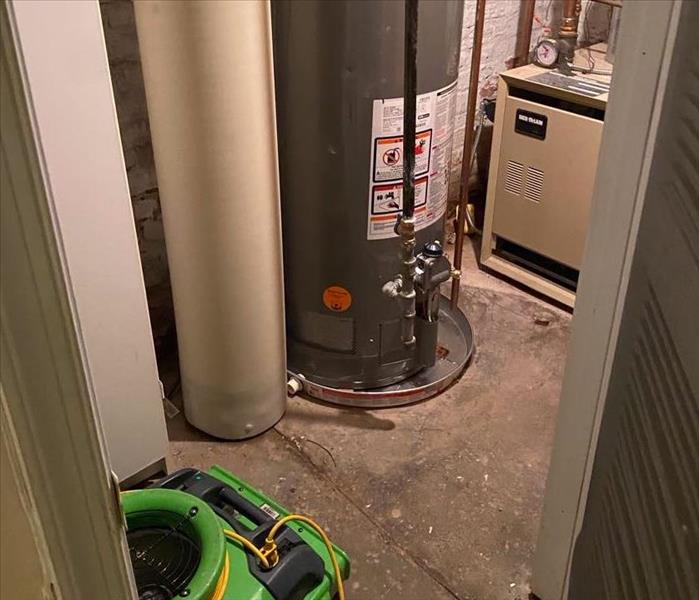 Water damage caused by a water leak in basement
Water damage caused by a water leak in basement
Water damage caused by heavy summer rains can create a messy and stressful situation. According to the American Insurance Association, water damage claims grow faster than other homeowner’s insurance claims. Every year, about one in 50 homeowners will experience water damage and file a claim.
At SERVPRO of College Park / Hyattsville and SERVPRO of District Heights / Landover, we have certified specialists with the specific water damage training who will walk you through this challenging and often confusing time. If you need emergency services, we recommend calling our SERVPRO team to get you the help you need.
For SERVPRO of College Park / Hyattsville Call: 301-779-3662
For SERVPRO of District Heights / Landover Call: 301-577-1166
Here are a few tips of what you can do before a SERVPRO technician arrives.
- Evaluate whether your property is safe to live in and hazard-free.
- If your property is safe, remove any slip and fall hazards.
- Identify visible mold growth.
- Stop the water source or minimize the flow of the water entering.
- Try to remove excess water by using a mop, a wet vacuum, or a cloth.
- Clean and dry small areas affected by water damage.
- Protect carpet and furnishings in the affected area.
- Remove any valuable items, including personal items, jewelry, and heirlooms.
When you call, a SERVPRO representative will go through some quick questions to help better understand your current situation. The following are examples of questions they will ask:
- Name and Contact information.
- Location of the affected property.
- Source of the water damage.
- Approximate time the water damage occurred.
- Rooms affected by the water damage.
- Have you seen signs of mold growing anywhere in the structure or its contents?
As you can see, immediate action is needed to minimize the damage, cleaning, and restoration costs. SERVPRO of College Park / Hyattsville and SERVPRO of District Heights highly trained technicians will get to work quickly on mitigating damage and restoring your home or business.
Water Damage From Hurricanes
4/30/2021 (Permalink)
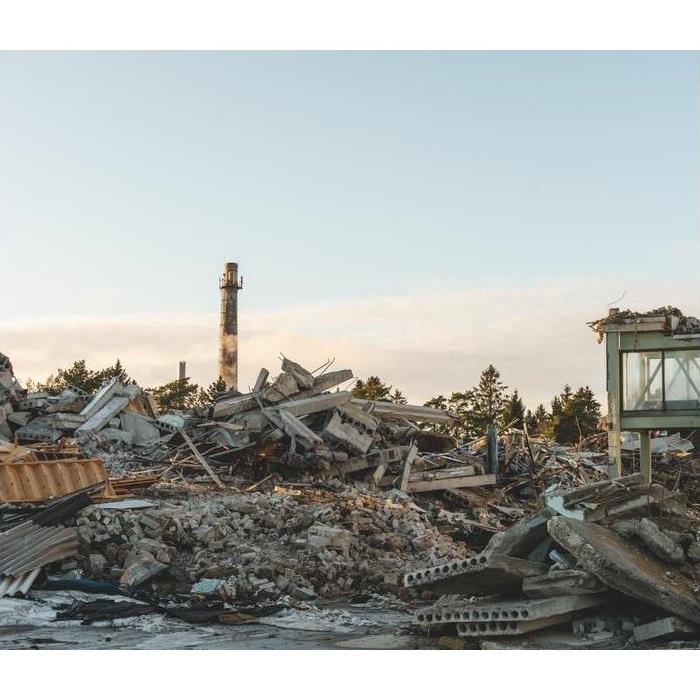 SERVPRO of College Park / Hyattsville and SERVPRO of District Heights / Landover specializes in mitigation and restoration services.
SERVPRO of College Park / Hyattsville and SERVPRO of District Heights / Landover specializes in mitigation and restoration services.
Heavy rain and damaging wind speeds can cause flooding in a matter of minutes. In our area, hurricane season begins June 1st to November 30th, with its peak in September. According to Ready DC, mapping out an emergency communication plan is essential. The National Weather Service provides safety regulations and alerts to keep us informed during the storm.
After The Hurricane
After the hurricane, rains and high winds usually cause flooding. Standing water is a breeding ground for all types of mold and bacteria. The level of damage to your home or business depends on how long the standing water is ignored. There is no set time frame to tell how long the water will be present in a business or residence.
After the hurricane has passed and before you think of entering your home, refer to this checklist.
- Be aware of wires, power lines, and places where the floor washed away
- Watch out for poisonous snakes and wild animals that may have entered your home
- Throw out food that could have been in contact with the water
- Document and take any photos of all damaged for your reference and the insurance
Call SERVPRO of College Park / Hyattsville (301) 779-3662 and SERVPRO of District Heights / Landover (301) 557-1166. No matter how big the job may be, we are here to help.
SERVPRO of College Park / Hyattsville and SERVPRO of District Heights / Landover specializes in storm and flood damage restoration. Our technicians at SERVPRO are highly trained professionals and use specialized equipment to restore your home or business to its pre-existing state. As our tagline states, “Like it never even happened.”
We Are Local And Can Get To You Faster
Since we are a locally owned franchise, we can get a dispatcher to your location as soon as possible. Having a fast response from our team lessens the damage and limits any further damages.
Hurricane Preparedness for Drinking Water Utilities
3/30/2021 (Permalink)
Reading time: 1 min 41 sec
Hurricane Preparedness for Drinking Water Utilities from SERVPRO of College Park/Hyattsville and SERVPRO of District Heights / Landover
Drinking water services must be proactive. Public water suppliers in the storm's path should brace themselves for
- high winds
- storm surge
- torrential rain
- flooding
- prolonged power outages.
SERVPRO understands how imperative drinking water utilities for the Prince George's County community. They must continue to provide their services before, during, and after the storm. Below are suggested hurricane preparedness tips for Drinking Water Utilities
Hurricane Preparedness Tips for Drinking Water Utilities
Water Storage
Fill the storage tanks to meet demand during a power outage. This will help anchor the tanks during high winds and flooding.
Back-Up Power
Refuel the generators' fuel tanks. Test each generator under load to ensure that they are operating. Also, check that power transmission is secure, in case of a prolonged power outage. Estimate how long it will take to meet demand using the backup power, fuel, and water storage on hand. Count the number of alternative fuel sources in case the main supplier is unable to supply them.
Continuity of Operation
Contact all-important workers and put them on high alert. Ensure that enough resources will be on duty for the duration of the predicted storm. Provide adequate food and clean water for employees who work long hours. Employees should bring extra dry clothing. Also, they should arrange their sleeping quarter so that extended duty staff does not get too tired.
Chemical and Fuel Storage
Check the tanks to ensure there are critical chemicals (e.g., disinfectant) to last the storm. Check that the tanks are anchoring to ensure that it is safe from wind damage and forces (floating or overturning) if it becomes submerged.
Water Sources
Determine which sources can become overburdened. Prepare to remove any sources that may be vulnerable to damage from a flood. This includes intrusion by flood-borne pathogens or saltwater before the flood.
Emergency Communications
Make sure the emergency communications equipment is in good working order. Both batteries should be changed or replaced. Distribute relevant communication equipment to the appropriate personnel.
Public Communications
Prepare to make public information available as appropriate. Check with local radio and television stations for contact information. If there isn't adequate storage and/or dedicated backup power for three days, consider pre-planning water conservation alert notices that can be released if necessary.
Vehicles
Fill vehicle fuel tanks to ensure that they are ready for use in the event of a storm. Provide necessary equipment (radios, instruments, tools, safety equipment, lights, ropes, etc.).
SERVPRO is Here to Help
If recent storms have caused flooding or a pipe has burst, our highly trained technicians are ready 24 hours a day, 7 days a week, to respond immediately to flood or water damage at your Prince George's property.
Learn more about our Water Damage Repair and Restoration >
Facts provided by EPA.gov
Water Damage Statistics
3/30/2021 (Permalink)
Reading time: 1 min 37 sec
Water Damage Statistics
Water damage can cause a wide range of losses. Homeowners recognize that wear and tear can occur in every situation; however, there is a range of unexpected incidents that can result in water harm. Natural disasters are often blamed for water pollution, and understandably so, considering that the majority of water-related losses are caused by an external environmental factor.
Nonetheless, water damage can manifest itself in a variety of ways. Understanding the causes of this form of harm is vital not just for avoiding an injury, but also for understanding where you stand in the eyes of your insurance company. Water damage in homes is most frequently caused by the following factors:
- Frozen pipes
- Leaking pipes
- Leaky roof
- Broken washing machine hose
- Plumbing problems
- Insulations issues
The water damage statistics provided below demonstrate the pervasiveness of this issue. Although many people do not consider water damage to be a normal event, it accounts for a large number of homeowners insurance claims. Some of the most interesting water damage figures are as follows:
- Almost 40% of all homeowners have reported that they have suffered financial losses as a result of water damage.
- Approximately 93 percent of all water damage can be avoided.
- Water damage is the second most common explanation for insurance claims in the United States.
- A 1/8-inch gap in a pipe leaks 250 gallons of water every day.
- Water damage accounts for nearly 20% of all insurance claims.
- Every year, billions of dollars in property losses are incurred as a direct result of water damage.
- Homeowners who realize the potential harm caused by water are far more likely to avoid problems before they become big issues.
Water Damage Insurance Coverage
Homeowners must be aware of what is and is not protected by their new insurance policy. Without this understanding, homeowners will be taken back if a disaster happens, and they are forced to pay for the losses out of pocket. In addition to buying a flood policy, you might be able to add coverage to your current policy. These additions may include the following.
- Mold remediation (varies on the state)
- Backup of drains or sewers
- Plumbing water damage
- Air conditioning damages
- Water heater damage
We Work With Your Insurance
For a stress-free claims process, SERVPRO can help manage the insurance paperwork and process. Call us for more details.
SERVPRO of College Park / Hyattsville and SERVPRO of District Heights / Landover
(301) 779 3662
Who Do You Call For A Flood?
3/17/2021 (Permalink)
Reading time:1 min 22 sec
Consider the following typical scenarios: Water pours through the downstairs ceiling and soaks the hardwood floors due to a leak in a second-floor supply line. A pipe bursts on the first floor, soaking carpets and the tile on the kitchen floor. You come home to a humid house with damp walls, a saturated roof, and standing water in the basement.
Obviously, in these situations, you contact SERVPRO of College Park / Hyattsville and SERVPRO of District Heights / Landover for assistance.
But what if the damage doesn’t look so bad and you're tempted to mop, towel, and fan instead? Here are a few things to think about:
Wet Seeks Dry
This means that water is constantly attempting to infiltrate dry building materials and contents. Moisture can cause warping, delamination, and staining depending on how long the water has been present. It takes time and a strategy to keep the water out of the flooring and drywall, just as it takes time and a strategy to get the moisture out. A specialist mitigation company, Like SERVPRO of College Park / Hyattsville and SERVPRO of District Heights / Landover experience, education, and equipment are frequently needed.
Secondary Damage from a Water Loss Can Exceed the Original Damage
For contractors coping with water loss, the insurance industry has a thick book of recommended guidelines. House floods, according to experience, destroy finishes, jeopardize the structural integrity of a building, and pose a health risk.
Our SERVPRO Team Has Seen It Before
We deal with variants of the above-mentioned circumstances hundreds of times a year. The only thing they share in common is a fear that problems will be fixed. We understand water and know that, no matter how familiar your dilemma is to us, it is terrifying, stressful, and disturbing to you.
In the unlikely event that we come across a situation that we haven't seen before, we can turn to our SERVPRO network for support and advice. SERVPRO is the biggest and most trusted organization in the United States.
There are no unimaginable messes for our SERVPRO Team. The cleaning process starts with a phone call.
Learn More About Our Water Damage Repair and Restoration >
CALL US TODAY!
(301) 779-3662
Protect Your Business While You're Away
3/15/2021 (Permalink)
There are a lot of reasons you may need to shut down your business in Prince George’s Country. If you're away, your site can be at risk of catastrophic flood damage. Water pipe repair is expensive, so consider doing some preventive work if:
- You work on a seasonal basis
- You have recently been the target of fire or other damage to the premises
- Your location has been shut down by legal authorities
- You move to another location and sell your former property
- You have temporarily suspended operations for updating or remodeling
No matter why you decide to close down your store, the last thing you want is to go back to the disaster area. Here are a few precautions that may avoid harm to the water when you and your workers are elsewhere.
Keep Your Equipment Working
One of the best ways to protect your location from water damage is by maintaining your flood control equipment. Sump pumps are by far the most common water treatment equipment, so check your pump batteries and ensure proper mechanical operation before you leave for any period of time.
Close the Valves
You may also shut down your main water control system. It's always a good idea to be familiar with the following control valves: Fast responses to broken pipes will save hundreds of dollars in water pipe repair costs down the road.
Insulate
Isolation is commonly known to be prevention against freezing. You might be able to get more out of insulating your pipes, though, even if you're not afraid of them bursting. A little insulation may control small leaks, secure sensitive equipment or interior finishes.
It's pretty easy to make sure you have a safe, dry place to get back to, not a flooded one. These are not the steps you want to take every time you leave. However, if you're planning to be gone for more than a few days, these simple processes might save you hundreds or even thousands of dollars in cleaning up and repairing water pipes.
What's in a Flood?
4/22/2020 (Permalink)
Not all water damages are the same. Many of our friends have found that out after recent flooding. The cleanup caused by recent flooding in much different than say a burst pipe you may have experienced in the past. In this blog we will look at the different water types.
What we call “clean” water when referring to water damage is water from a broken supply line for example. Clean water is pretty self-explanatory; it comes from a clean source. Rain water CAN be considered clean water if it is an isolated incident not related to wide spread flooding.
The second type of water is “grey” water. Grey water is slightly contaminated water. A good example of grey water is drain from a dishwasher. Keep in mind that water types can change. Clean water left too long without cleanup becomes grey water as bacteria and other contaminates can begin to grow.
The final classification is “black” water. Black water is highly contaminated as it is the result of encountering sewage, chemicals, or harmful bacteria. The tragic flooding we experienced this spring would be considered black water. Yes, we said earlier rain water was considered clean but as this water flowed out of control through farms and cities it picks up contaminates. Flooding to this extent has mixed with local sewage systems, as well as been in contact with an endless list of chemicals and contaminates.
SERVPRO always recommends you leave water damage cleanup to the professionals but we cannot stress enough how harmful black water can be. The type of water determines our protocol for proper cleanup. When handled improperly, it is easy to contaminate other areas of your home or business and instead of mitigating damage you may accidentally increase it. Black water should always be left to the pros.
Spring Mold Prevention
4/21/2020 (Permalink)

Birds are singing, flowers are blooming, and temperatures are getting warmer little by little. It’s evident that spring is in the air. Spring weather motivates us to open windows and breathe in the fresh air, but it may be surprising to know that doing so can increase the chances of mold growth in your home due to the presence of moisture and humidity in the air. Many different surfaces, such as carpet, wood, and insulation, can serve as reservoirs for mold as long as moisture is present. It is also important to note that mold is capable of growing at any point during the year, but warmer temperatures and greater humidity in the spring increase the risk of mold growth during the season. Understanding what actions you can take in order to prevent mold growth will prove absolutely essential in protecting your home and those living in it from the harmful effects of mold this spring.
It is extremely important when protecting your home from mold growth during the spring to facilitate the circulation of air within your home so that warm air will not become stagnant in one area. Air can be circulated efficiently with the help of fans and moisture in the air can be decreased through the use of a dehumidifier. It is important to remember that humidity levels indoors should not be greater than 45%. It may also be beneficial to keep an eye on areas of the home that are cold or dark, which are especially susceptible to mold growth. To help prevent mold growth in these areas, do your best to expose these areas to natural or artificial light.
Finally, after rain showers or storms, which are prevalent during the spring, make sure to frequently check areas around windows and doors for mold growth. Moisture from rain water can gather around windows and doors, which can lead to mold growth if not dried immediately. Additionally, because temperatures indoors and outdoors differ during the springtime, condensation is often prevalent on doors and windows. Moisture from condensation, when met with humidity, can also lead to mold growth if the area is not dried.
If mold becomes visible on a surface in your home, be sure to diligently scrub the surface with water and detergent. After doing so, make sure that you dry the surface thoroughly in order to prevent further mold growth in that area. Small-scale, isolated mold growth is typically manageable, but larger-scale mold growth can be overwhelming and require professional remediation. Call the mold remediation specialists at SERVPRO in order to assess the situation and take care of your home’s mold infestation in a timely manner.
Rain, Rain, Go Away!
3/27/2020 (Permalink)
There is never a good time for it to be raining inside a building. An in-depth job scope and work plan are developed quickly to get the water out and dry the interior. Industrial water extractors, a desiccant dehumidifier the size of a tractor trailer, plenty of staff, and SERVPRO know-how to get the job started quickly and correctly. Working around the clock for days, our employees and hundreds of pieces of equipment work away to get the elementary school cleaned up and ready for the first day of school.
What a sense of satisfaction it is to see this school opening right on time due to the hard work of our SERVPRO employees along with the faculty and staff of the school and the community!! It just goes to show that no job is too big or too small for our SERVPRO team.
With over 50 years in the industry, we know just what to do in the case of a water event that causes damage to a school, business or home! We make it "Like it never even happened."
Be Prepared for When Storms Hit
3/27/2020 (Permalink)
Whether there is heavy rain, freezing temperatures, damaging winds, or sleet and snow, all of these can cause property damage. You can't control mother nature, but you can be prepared.
Here are some tips to help you:
-Check for tree limbs and branches that might have fallen.
-Roofs, pipes and gutters should all be inspected and make sure they are in proper working order. Clear gutters from debris, a damming effect could cause roof damage or interior water problems. Downspouts should be facing away from the home or building.
-Clean your chimneys and exhaust systems from debris.
-Test your gas lines for leaks.
-Inspect your property for proper drainage.
-Protect pipes from freezing by allowing water to drip when temperatures dip below freezing. If any pipes are under cabinets leave the cabinets open. Make sure exterior pipes are properly insulated.
-If there are any outdoor faucets, you might want to shut the water off.
-Make sure all exterior doors and windows have sufficient weather stripping.
Unexpected Water Damage
3/26/2020 (Permalink)
SERVPRO is available 24 hours a day for water emergencies, large or small. When you are dealing with water damage, immediate action is crucial. A delay of just a few hours can greatly increase the severity of the water damage.
We understand that when you call us, you may be feeling confused, stressed, and vulnerable. You need an expert to guide you through this crisis. SERVPRO has the specific water damage training and experience to help you through this tough time. We specialize in water damage restoration—in fact, it is the cornerstone of our business.
What to Expect
When you call us, we will ask questions regarding your water damage emergency. These questions will help us determine what equipment and resources to bring. This includes how many trained SERVPRO professionals we may need.
Our SERVPRO Representative will ask questions:
- Your name and contact information
- Your insurance information (if applicable)
- The street address of the water-damaged home or business
- When did the flooding or water damage occur?
- What caused the water damage (if known)?
- Is there electricity available (on-site)?
SERVPRO of College Park / Hyattsville is here for you 24/7 all 365 days of the year. Call us at 301-779-3662.
Faster to Any Size Water Damage
3/26/2020 (Permalink)
SERVPRO provides 24/7/365 fire and water damage restoration service.
We do not wait for regular business hours. SERVPRO provides emergency cleaning and restoration services 24 hours a day, 7 days a week—including all holidays.
Faster To Any Size Disaster
Flooding and water damage is invasive. Water quickly spreads throughout your home and gets absorbed into floors, walls, furniture, plus more. SERVPRO arrives quickly and starts the water extraction process almost immediately. This immediate response helps to minimize the damage and the cleaning and restoration costs.
- Water quickly spreads throughout your property, saturating everything in its path.
- Water is absorbed into walls, floors, upholstery, and belongings.
- Furniture finishes may bleed, causing permanent staining on carpets.
- Photographs, books, and other paper goods start to swell and warp.
Hours 1 - 24:
- Drywall begins to swell and break down.
- Metal surfaces begin to tarnish.
- Furniture begins to swell and crack.
- Dyes and inks from cloth and paper goods spread and stain.
- A musty odor appears.
48 Hours to 1 Week:
- Mold and mildew may grow and spread.
- Doors, windows, and studs swell and warp.
- Metal begins to rust and corrode.
- Furniture warps and shows signs of mold.
- Paint begins to blister.
- Wood flooring swells and warps.
- Serious biohazard contamination is possible.
More Than 1 Week:
- Restoration time and cost increase dramatically; replacing contaminated materials and structural rebuilding may be extensive.
- Structural safety, mold growth, and biohazard contaminants pose serious risks to occupants.
If you need further assistance with your water damage, please call SERVPRO of College Park / Hyattsville at 301-779-3662.
Water Damage Clean Up Is Not a D.I.Y. Project
3/12/2019 (Permalink)
We live in the Do-It-Yourself era. Home improvement stores and television shows promote it all the time. Heck, there is an entire television network dedicated to DIY programing. Many projects can be tackled by the weekend DIY pro. It can be a great way to reduce home improvement costs. Many people find pleasure and satisfaction in these projects. Today, we want to talk about a project that we recommend you not try to tackle yourself and that is water damage.
Depending on the source of the water intrusion, you may be dealing with various pathogens that can cause serious illness or death. Sewer backup is an example of a category 3 contamination. Category 3 should never be handled except by a profession with the proper personal protective equipment to protect themselves and the proper training so other parts of the structure are not cross contaminated. Another example of a category 3 loss is flood waters from storms and swollen rivers and creeks.
Even lesser category losses can be harmful and need to be handled with care. Washing machine and dishwasher discharges are example of category 2 losses but can contain contaminates that can cause a reaction or illness. The time in which water sits is also a reason for concern. Even a category 1 loss such as a sink supply line busting, if let to sit for a few days can rapidly progress to category 2 or 3 as bacterial and microbial growth begins.
Mold is always a potential issue no matter the level of contamination of the water. This is where it gets tricky for the DIY person. People usually get blindsided by mold growth not from the moisture they seen and thought they took care of but by the hidden moisture. The carpet may feel dry to the touch a few days later but the pad may still be holding moisture, or the subfloor. Drywall will “wix” moisture up from a wet floor like a straw. Many times, moisture left on the backside of sheetrock is the beginning of extensive mold growth. Don’t chance it. SERVPRO has the training and technology to detect all moisture and properly dry all affected areas.
In the long run it will save you a lot of money. Money that can be used for all of the great DIY improvement projects you love.
4 Hour Emergency Water Damage Service
3/12/2019 (Permalink)
SERVPRO is available 24 hours a day for water emergencies, large or small. When you are dealing with water damage, immediate action is crucial. A delay of just a few hours can greatly increase the severity of the water damage.
We understand that when you call us, you may be feeling confused, stressed, and vulnerable. You need an expert to guide you through this crisis. SERVPRO has the specific water damage training and experience to help you through this tough time. We specialize in water damage restoration—in fact, it's the cornerstone of our business.
What to Expect
When you call, we will ask several questions regarding your water damage emergency. These questions will help us determine what equipment and resources to bring, including how many trained SERVPRO Professionals may be needed.
Our SERVPRO Representative will ask several questions:
· Your name and contact information
· Your insurance information (if applicable)
· The street address of the water-damaged home or business
· When did the flooding or water damage occur?
· What caused the water damage (if known)?
· Is there electricity available (on-site)?
What is In Flood Water?
3/12/2019 (Permalink)
Not all water damages are the same. Many of our friends have found that out after recent flooding. The cleanup caused by recent flooding in much different than say a burst pipe you may have experienced in the past. In this blog we will look at the different water types.
What we call “clean” water when referring to water damage is water from a broken supply line for example. Clean water is pretty self-explanatory; it comes from a clean source. Rain water CAN be considered clean water if it is an isolated incident not related to wide spread flooding.
The second type of water is “grey” water. Grey water is slightly contaminated water. A good example of grey water is drain from a dishwasher. Keep in mind that water types can change. Clean water left too long without cleanup becomes grey water as bacteria and other contaminates can begin to grow.
The final classification is “black” water. Black water is highly contaminated as it is the result of encountering sewage, chemicals, or harmful bacteria. The tragic flooding we experienced this spring would be considered black water. Yes, we said earlier rain water was considered clean but as this water flowed out of control through farms and cities it picks up contaminates. Flooding to this extent has mixed with local sewage systems, as well as been in contact with an endless list of chemicals and contaminates.
SERVPRO always recommends you leave water damage cleanup to the professionals but we cannot stress enough how harmful black water can be. The type of water determines our protocol for proper cleanup. When handled improperly, it is easy to contaminate other areas of your home or business and instead of mitigating damage you may accidentally increase it. Black water should always be left to the pros.
Water you don't see can cost you money.
3/12/2019 (Permalink)
Water is the single most amazing substance on the planet. Over 70% of the planet’s surface is covered by water. Our bodies are made up of over 60% water. Life as we know it is not sustainable without water. If you’re in the water damage restoration business what may amaze you the most is water’s incredible ability to travel. Water has an uncanny ability to travel around, over, and through about anything. For this fact, we at SERVPRO often talk about the water you don’t see. Hidden moisture can cause serious damage to your home or business and even your health. That is why even perceived “small” water damages should be handled by professionals.
To protect your investment you really need to view every water intrusion as a real threat. SERVPRO has the experience, training, and the tools to properly scope water damaged property. Today we want to focus on the basic tools we use track the moisture.
- Moisture Sensors are used to detect moisture. They can detect moisture in drywall, carpets, moldings, and other building materials. This tool is used to map out the full extent of the affected areas. What may appear dry or be dry to the touch may be affected and this tool helps us find all the moisture.
- Moisture Meters are used to actually measure the amount of moisture in the materials. This is a vital part in determining a drying strategy. Moisture meters are used throughout the drying process as areas are monitored daily to document the progress in drying.
- Thermohygrometers measure temperature and relative humidity. SERVPRO techs use this information to create an environment in which materials can dry. As with the meters, this tool is used throughout the project to measure and document the progress of drying.
With a full and complete understanding of the severity of a water intrusion SERVPRO can eliminate the possibility of secondary damage resulting from a flood. A call to SERVPRO brings immediate action with our full arsenal of tools to prevent the further spread of water and the possibility of further damage such as rot an
Winter Temps in Spring? Be Prepared
3/12/2019 (Permalink)
Be safe and disconnect hoses if temperatures near freezing.Even for standards, this winter and early spring has been crazy! The official first day of spring was a weeks ago but you will be able to tell that by the nighttime low temperatures in this weekend’s forecast.
Everyone is in a scramble to cover outdoor plants and flowers to try to save them from the unusual cold temps. There is probably another thing you need to protect. Your outside faucet. As the temperatures have warmed over the last few weeks many of us have embarked on outdoor projects in the yard. Many of us have de-winterized the outside faucet and have connected hoses to complete chores.
Now a full weatherization like you do in the autumn with an insulated cover is probably not necessary but you do need to make sure your outside hose has been disconnected. The water in the connected hose is directly affected by the elements. When it freezes it can put pressure on the plumbing it is connected to and can lead to big time problems.
void Washing Machine Disasters
3/12/2019 (Permalink)
Water damage from a malfunctioning washing machine are common.
According to the US Census over 85% of American homes have a washing machine. Washing machines are viewed today as an essential part of life. They provide an efficient and sanitary place to clean our clothes and other soiled textiles. But is your washing machine a ticking water damage time bomb?
Home floods resulting from a malfunctioning washing machine is in the top ten categories for water damages according to insurance carrier’s data. Over half the time the water supply line into the machine is the culprit. The life span of a washing machine supply line is less than 9 years. How old are yours?
There are other parts of the machine that can malfunction. Pump malfunctions or drain hoses being disconnected can result in a serious water intrusion. The average cost of a claim from a washing machine when the customer is home and catches the problem relatively quickly is just under $5,000. These accidents don’t always happen when we are home, if the property is unoccupied the results can cost into the tens of thousands of dollars to fix.
So, what can you do to prevent these kinds of losses?
- Make sure the drain hose is firmly secured and cannot easily be jarred free from the drain.
- If your supply hoses are more than 5 years old think about replacing them. Especially if they are made of rubber. The metal braided hoses are much more durable.
- Don’t snug your washing machine to close to the wall. Being to close to the wall may cause kinks in the hoses. While water may be allowed through the restricted area it causes a stress point for the hoses exterior to break down.
Prevent Water Damage to Your Furnace This Winter
9/27/2018 (Permalink)
Every winter, especially if you live in a cold climate, your home is under assault from the elements. Eventually, that constant assault can cause your home’s systems to fail. One common result of these failures is water damage. And while any type of water damage is bad, there are certain types of damage that can be worse than others. That’s especially true in the winter.
Perhaps no system in your home is more important in the winter than your furnace. Without it, you’d be in big trouble. So while the impact of home water damage is bad no matter how you look at it, having your furnace damaged when the temps are freezing outside can be catastrophic. So let’s talk about things you can do to protect your furnace from water damage should the worst case scenario happen to you this winter.
Furnaces are hidden from view for a reason. They’re not exactly focal points of a home you want people’s eyes drawn towards. Whether it’s in a crawl space, basement or mechanical closet, it’s typically in a place you naturally don’t find yourself visiting very often. One way to help protect your furnace from water damage is to create an elevated platform upon which the furnace can sit. If it’s the case your furnace is found in an unfinished basement, you can simply pour a concrete block and install the furnace there. If it’s in a closet, it may make more sense to create a wooden box to hold the furnace. In either case, having the additional 18-24″ of height can typically protect against most types of home water damage. Granted, in massive flood events this isn’t going to have much effect, but then again there isn’t much you can do from a preventative stand point when mother nature decides to take charge.
Who are you going to call?
9/18/2018 (Permalink)
Your water damage is new; who do you call? If I were you I wouldn't call a new company, call one that's been around and has the experience your looking for.
SERVPRO has been around since 1967 with over 1500 franchises. To say SERVPRO knows " a little bit about water damage" is an understatement.
SERVPRO is an expert in water damage. Our professionals go through extensive training and certification to make sure your getting the most up to date techniques available.
SERVPRO's leadership has earned the trust of the insurance industry, homeowners, commercial property managers and even the Pentagon.
Rain, rain go away or at least stay outside
9/18/2018 (Permalink)
Rain is great for your yard but not to get inside your home.
Many people wake up from a rain storm to a wet basement. It may be from the foundation or could be a pipe leakage, sub pump failure. Many things could have happened and you will want to determine how it happened to get the right person out to repair.
In all the cases though you are going to want to call an expert in helping you to dry out your basement. That expert would be SERVPRO
We can get right to work in getting the water up , drying the structure etc. SERVPRO has the knowledge as to what can be dried and saved and what is better off being throw away.
Did you know that organic materials like paper, fabric, wood, leather can start to grow mold in as little as a day? Let SERVPRO help you save as much as possible of your things.
The Four Classes of a Water Damage
8/27/2018 (Permalink)
4 Classes of Water Damage
Classes of water losses are determined by the rate of evaporation based on the type of materials affected by water damage to your property. Determining the Class of Water is an important first step, and will determine the amount and type of equipment utilized to restore your business. There are four IICRC water damage classifications, they are as follows:
Class 1 - Slow Evaporation Rate
Water losses that affect only part of a room or area, or losses with lower permeance/porosity materials (e.g., plywood, particle board, structural wood, vinyl composition tile or VCT, concrete). Little or no wet carpet or cushion is present. Minimum moisture is absorbed by materials, releasing moisture slowly.
Class 2 - Fast Evaporation Rate
Water losses that affect an entire room or carpet and cushion. Water has wicked up walls 12" - 24". There is moisture remaining in structural materials (e.g., plywood, particle board, structural wood, concrete).
Class 3 - Fastest Evaporation Rate
Water may have come from overhead. Ceilings, walls, insulation, carpet, cushion and sub-floor in the entire area are saturated.
Class 4 - Specialty Drying Situations
These consist of wet materials with very low permeance/porosity (hardwood, plaster, brick, concrete, stone, and crawlspace). Typically, there are deep pockets of saturation, which requires very low specific humidity.
Water : Clean Vs Contaminated
10/5/2017 (Permalink)
When you have a water damage, don’t leave your property to chance. Call SERVPRO of College Park/Hyattsville. Consider the following steps to help minimize damage or prevent further damage while waiting for help to arrive.
Damage from Clean Water:
· Shut off the water source if possible or contact a qualified professional to do so.
· Turn off circuit breakers for wet areas of the building, if access to the power distribution panel is safe from potential electrical shock.
· Remove as much excess water as possible by mopping and blotting.
· Wipe excess water from wood furniture after removing lamps and tabletop items.
· Remove and prop up wet upholstery cushions for even drying.
· Place aluminum foil or wood blocks between furniture legs and wet carpeting.
Damage from Contaminated Water:
· Avoid all contact with sewage and items contaminated by sewage.
· Do not walk through contaminated areas, as you could spread damage to unaffected areas.
· Do not turn on HVAC system if there is a possibility of spreading contaminated air.
· Do not use household fans to dry the structure; air flow could spread contaminants.
· Discard any food and/or products for personal hygiene and cleanliness if exposed to the contaminated areas.
Note: If exposed to harmful waste, OSHA recommends a post-exposure medical evaluation. Consult your local health department or physician.



 24/7 Emergency Service
24/7 Emergency Service

